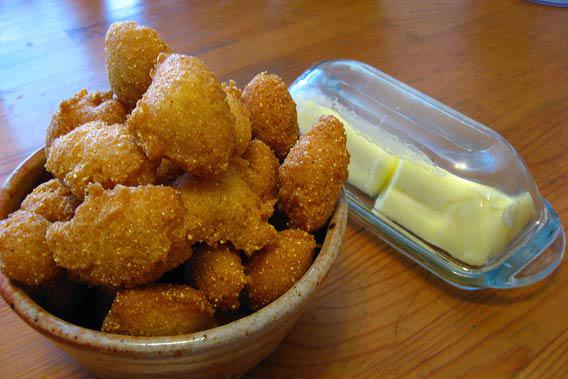The hushpuppy is made of cornmeal, buttermilk, eggs, salt, baking powder, and onion. These ingredients are mixed and dropped into a skillet gurgling with oil or shortening. The result is a hissing-hot globule of just-set batter wobbling within a golden-brown shell—usually spherical, but sometimes tubular like a lipstick applicator. Crisp millimeter for millimeter, precious fat gram for fat gram, the hushpuppy is the best fried food in existence.
I have come to this conclusion after more than 25 years of traveling the world’s grease-stained wonderlands. In Japan I have enjoyed wispy and ethereal nanohana tempura. In Italy I have eaten arancini con burro—deep-fried risotto balls engorged with béchamel. On Greek islands I have eaten smelts dipped in pungent skordalia. I have done fried artichokes with lemon, fried chicken, onion rings, fish and chips. The humble hushpuppy remains the height of deep-fried achievement.
A properly prepared hushpuppy is an unparalleled dining experience. The first thing you notice is the toasty cornmeal, a scent that should be piped into grocery stores like Muzak. One bite into its fryer-honed armor and it collapses, releasing velvety guts with a consistency somewhere between dense pudding and bread. Flecks of onion add bright, savory notes, ground pepper a subtle jolt. The only improvements that can be made to its soothing near-blandness and its harmonious textural balance are a touch of tartar sauce and splashes of vinegary Crystal Hot Sauce.
Adding to hushpuppies’ appeal is their humbleness. They are comprised of appealingly cheap staple ingredients. Though it first appeared in cookbooks (as “drop cornbread)” in Mrs. H. W. Wilson’s New Cook Book in 1914, North Carolina chef and culinary historian Rick McDaniel guesses that the dish was probably first prepared at least a generation before then. “It’s a cornmeal dough,” McDaniel says. “You can’t tell me that somebody in the South didn’t try frying that before the 20th century.”
That’s because hushpuppies are, for lack of a better term, peasant food. They’re a side dish designed to fill a diner up when the blistered perch curled around the fish plate is insufficient, or when the anglers have come home empty-handed. A hushpuppy costs a penny. It’s something substantial conjured out of almost nothing. A simple triumph of opportunity and ingenuity over poverty, the hushpuppy is one of the most American foods imaginable, an embodiment of the pioneer spirit. It also has roots in some of America’s underappreciated culinary influences, including Native American cornmeal cuisine and the West African frying tradition.
The hushpuppy has several terrific origin myths. One story holds that hushpuppies were first fried around 1727 by a group of French nuns who settled in Louisiana; these slightly sweetened croquettes de maise became popular throughout the Southern states. Another legend credits the naming of the hushpuppy to a Creole cook in Atlanta, who ostensibly hurled one of the croquettes to a dog so it would stop yapping. The howling pup narrative pops up again and again in hushpuppy lore, whether the cooks in question are traveling salesmen, hunters, fur trappers, Florida sugar plantation workers, fishermen, or Confederate soldiers. In the most popular narrative, it’s a group of men huddled around a campfire who fry cornmeal batter in grease and toss the result to noisy hounds. In the soldier variation, the hounds must be hushed so they won’t reveal their owners’ position to Union troops on the prowl.
I discovered hushpuppies during high school, not as a diner but as a cook. At age 16, at a seafood shack in Louisville, Ky., I mostly stirred cauldrons of mushy green beans, shook jugs of mayonnaise into vats of slaw, and casually scrubbed at burnt bits clinging to the bottom of pans. But sometimes I was tapped to man the fryer, cooking pound after pound of “Boston scrod,” catfish, oysters, clams, shrimp, frozen french fries, and, of course, hushpuppies—to me, the most exotic entry in our restaurant’s oily portfolio. From time to time, I burned an order and had to eat my mistakes—but even dark walnut and faintly acrid, they were delicious.
If that job taught me anything, it was to respect the magic of bubbling oil and not try to meddle with it. The hushpuppy’s basic ingredients hardly vary, and only a few variations are defensible. Milk or water can replace the buttermilk. Sometimes baking soda replaces or complements the powder. The cooking fat may be lard or oil, either concurrently or previously used to cook fish. The onion may be grated, dehydrated, or minced. The dough often contains a bit of sugar, which McDaniel identifies as a deviation from traditional Southern cornbread. Adding a little jalapeno is OK, but that’s the craziest you should get. Country ham, crawfish, or fresh corn are “sacrilege,” to quote McDaniel. When flashy foods end up in the mix, the batter becomes a vessel for the more illustrious company, and the hushpuppy is no longer a hushpuppy—it’s a fritter.
This point hints at another reason for the hushpuppy’s fried-food supremacy: It’s not a fine food that is enhanced by frying. On the contrary, it is nothing without frying. The french fry is only one method of improving upon the potato’s natural form. Chicken can be very good cooked in other ways. Risotto may be transcendent even when it’s not rolled into balls and fried. Wet cornmeal generally resembles a face peel or something you could use to caulk a bathtub. When cooking hushpuppies, you don’t want to lick your sticky, grainy fingers like a gleeful chocolate chip cookie baker. But fried in oil, that batter reaches the absolute zenith of its ingredients’ potential. A simple preparation leavened with soul and mystery, hushpuppies are cornmeal in a state of grace.
